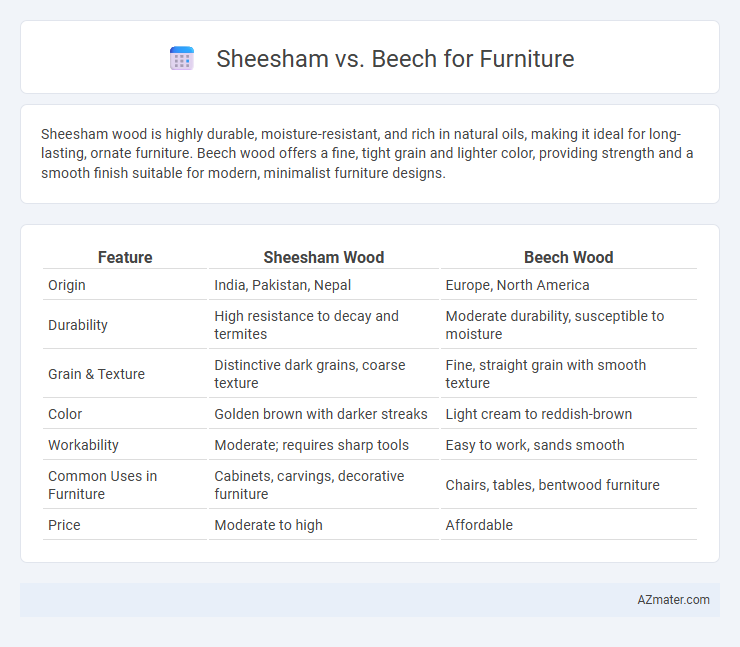Sheesham wood is highly durable, moisture-resistant, and rich in natural oils, making it ideal for long-lasting, ornate furniture. Beech wood offers a fine, tight grain and lighter color, providing strength and a smooth finish suitable for modern, minimalist furniture designs.
Table of Comparison
| Feature | Sheesham Wood | Beech Wood |
|---|---|---|
| Origin | India, Pakistan, Nepal | Europe, North America |
| Durability | High resistance to decay and termites | Moderate durability, susceptible to moisture |
| Grain & Texture | Distinctive dark grains, coarse texture | Fine, straight grain with smooth texture |
| Color | Golden brown with darker streaks | Light cream to reddish-brown |
| Workability | Moderate; requires sharp tools | Easy to work, sands smooth |
| Common Uses in Furniture | Cabinets, carvings, decorative furniture | Chairs, tables, bentwood furniture |
| Price | Moderate to high | Affordable |
Introduction: Sheesham vs Beech for Furniture
Sheesham and Beech are popular hardwood choices known for durability and aesthetic appeal in furniture making. Sheesham wood, rich in natural oils, offers resistance to insects and water, making it ideal for solid, long-lasting furniture pieces. Beech wood features a fine grain and uniform texture, providing excellent workability and an attractive light color suitable for modern and classic furniture designs.
Overview of Sheesham Wood
Sheesham wood, also known as Indian rosewood, is highly valued for furniture due to its rich, dark brown color with contrasting grain patterns, offering both durability and aesthetic appeal. Its natural oils make the wood resistant to decay and pests, which enhances the longevity of furniture pieces made from it. Compared to beech, Sheesham provides a more distinctive grain and greater hardness, making it ideal for ornate carvings and sturdy furniture construction.
Overview of Beech Wood
Beech wood is a popular hardwood choice for furniture due to its durability, fine grain, and smooth texture, making it ideal for both structural and aesthetic purposes. Its light color ranges from pale cream to pinkish brown, offering versatility in staining and finishing for various interior styles. Beech wood's strength and resistance to wear make it suitable for high-traffic furniture pieces, providing long-lasting value in home and office settings.
Durability and Strength Comparison
Sheesham wood, also known as Indian rosewood, offers superior durability and strength due to its dense grain and natural oils resisting decay and insects, making it ideal for long-lasting furniture. Beech wood, while strong and hard with a fine, even texture, is generally less dense and more prone to moisture damage and wear over time. For furniture requiring heavy use and longevity, Sheesham provides better structural integrity and resistance to environmental factors compared to Beech.
Aesthetic Differences: Grain and Color
Sheesham wood showcases a rich, dark brown color with intricate grain patterns featuring striking streaks and natural swirls that enhance the visual appeal of furniture pieces. In contrast, Beech wood exhibits a lighter, creamy tone with a fine, straight grain that offers a more uniform and subtle aesthetic. The bold, dramatic grains of Sheesham create a luxurious, rustic look, while Beech's consistent texture provides a modern, minimalistic charm.
Workability: Processing and Finishing
Sheesham wood offers excellent workability with a fine, even grain that responds well to cutting, carving, and sanding, making it ideal for intricate furniture designs. Beech wood is known for its smooth texture and uniform grain, providing consistent machining and easy staining or painting finishes. Both woods achieve high-quality surfaces, but Sheesham's natural oils enhance its polish and durability compared to Beech's more neutral finish.
Resistance to Pests and Decay
Sheesham wood exhibits superior resistance to pests and decay due to its natural oils and dense grain, making it highly durable for furniture use in humid environments. In contrast, Beech wood is more susceptible to fungal attacks and insect infestation because of its porous structure and lack of natural preservatives. Opting for Sheesham ensures longer-lasting furniture with minimal maintenance against wood-boring pests and rot.
Cost and Availability
Sheesham wood, known for its durability and rich grain, tends to be more expensive than Beech due to limited availability and slower growth rates. Beech is more readily available, making it a cost-effective choice for furniture that requires a balance of strength and affordability. Pricing for Sheesham furniture generally reflects its premium quality and scarcity, while Beech offers widespread accessibility and consistent pricing.
Environmental Impact and Sustainability
Sheesham wood, also known as Indian rosewood, is considered more sustainable due to its faster growth rate and widespread availability compared to Beech, which grows slower and is less abundant in certain regions. Sheesham's natural resistance to pests and decay reduces the need for chemical treatments, minimizing environmental harm, whereas Beech often requires such treatments to enhance durability. The harvesting practices and certification status of both woods significantly influence their overall environmental impact, with responsibly sourced Sheesham often preferred for eco-friendly furniture production.
Conclusion: Which Wood is Better for Furniture?
Sheesham wood offers superior durability, rich grain patterns, and natural termite resistance, making it ideal for high-quality, long-lasting furniture. Beech wood is valued for its fine texture, smooth finish, and workability, suitable for lighter indoor furniture. Considering strength and aesthetic appeal, Sheesham is generally better for premium, durable furniture, while Beech is preferred for budget-friendly, everyday pieces.

Infographic: Sheesham vs Beech for Furniture
 azmater.com
azmater.com